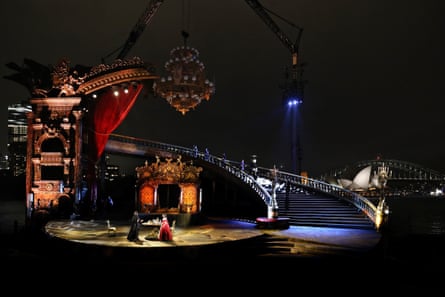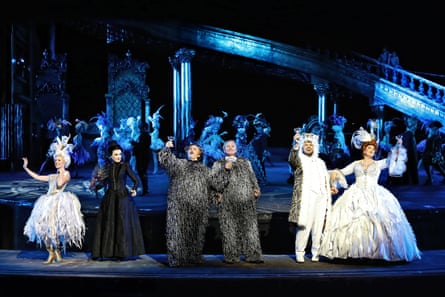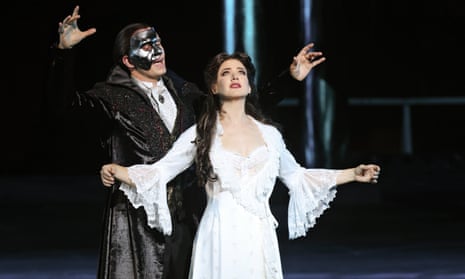You know the old adage about buses, right? You wait for one for ages, then two turn up.
It’s been 14 years since the last production of Andrew Lloyd Webber’s Phantom of the Opera played in Sydney, when Anthony Warlow reprised the title role that made him an international star. Now, in the space of a few months – thanks to Covid – the city will host two within the space of six months.
Josh Piterman will be stalking Sydney Opera House’s Joan Sutherland Theatre later this year in Australia’s first look at the refreshed Phantom that reopened on the West End in 2021.
But first up is this supersized one-off staging, directed by Simon Phillips and mounted on a huge pontoon anchored off the Domain’s Fleet Steps, before an audience of up to 3,000 per night.
A Phantom al fresco? It doesn’t seem a natural fit. It’s a drama of interiors – physical and psychological – and gloomy ones at that. How does a story that revels in the subterranean stand up against a glittering skyline? What chance does a lake of dry ice have in a harbour breeze? Where the heck is the hanging point for the swinging chandelier?
The bulk of the credit should go to designer Gabriela Tylesova for making Phantom work as well as it does. Her set (a tower of baroque theatre boxes topped with a sharp beak of broken proscenium; a staircase sweeping across the backstage and down) makes this outsized experience feel surprisingly intimate.

Phantom is a simple story, and often in the hands of actors in pairs or threes. Under Tylesova’s eye, on a stage that’s more than twice as large as any indoor stage in Australia, nothing about the drama is made to seem puny.
Phillips has cast a mix of new stars and old hands. The leading trio – Joshua Robson (the Phantom), Georgina Hopson (Christine) and Callum Francis (Raoul) – are making their Phantom debuts. There are some notable show veterans on hand, too. Taking leave from the Broadway production, Maree Johnson (Christine in the very first Sydney Phantom, taking over from Marina Prior) gives us her Madame Giry. Michael Cormick, who played Raoul on the West End for two-and-a-half years, is Firmin.
Robson brings bounding energy and a booming voice to the title role. Stentorian when the melodrama is at maximum (when, for example, he makes a grand entrance in a chariot suspended from one of the set’s two tower cranes), he’s also adept at giving us the G-forces of the Phantom’s rollercoasting emotions.
Hopson is an ideal match as Christine. Her colour, control and range are apparent throughout. Raoul is easy enough to make dashing but Francis captures his callowness and sensitivity, too.
Cormick and Martin Crewes are excellent value as theatre managers Firmin and Andre. Soprano Naomi Johns is funny and vocally fabulous as the tempestuous Carlotta and perfectly partnered by Paul Tabone as the comic tenor Ubaldo Piangi.

Tylesova’s costuming (big on bird feathers) is inventive and eye-catching. The 30-strong ensemble has a lot of ground to cover and while some of the exits and entrances seem ponderous compared to those in a more conventionally scaled show, when they look this good you’re happy to watch them.
The aforementioned chariot descent looks a little silly. The chandelier crash is probably the slowest I’ve ever seen. It’s enormous but it lands gently, like a wounded UFO. A spurt of fireworks goes up, as if triggered by an electrical malfunction.
There’s no lake of dry ice here but a ring of fire looks fantastic, even if it momentarily places the Phantom into Johnny Cash territory. But the climax of the piece, and the Phantom’s final disappearing act, missed some beats on this occasion and need fine tuning.

Under Guy Simpson’s baton, the orchestra (which plays under the stage, hidden from sight) delivers the score with the ample feeling and brassy colours that the traditional 27-member complement of musicians can generate. Chances are this will be the last time you hear it thus; the West End refresh of the show features a pit band of 14 players, with woodwind, brass and some violin parts delivered on digital keyboards.
Lloyd Webber was present on this opening night, on stage for the curtain call and delivered a short DJ set at the after party. He brought some meteorological good fortune with him. Moody skies had everyone primed for a drenching at some point, but the rain stayed away until 10 minutes after curtain call.
Opera on the Harbour shows are designed to withstand a soaking and don’t stop for anything but the worst. Make sure, in this La Niña phase, you’re ready for anything.
Phantom of the Opera plays on Sydney Harbour until 24 April
